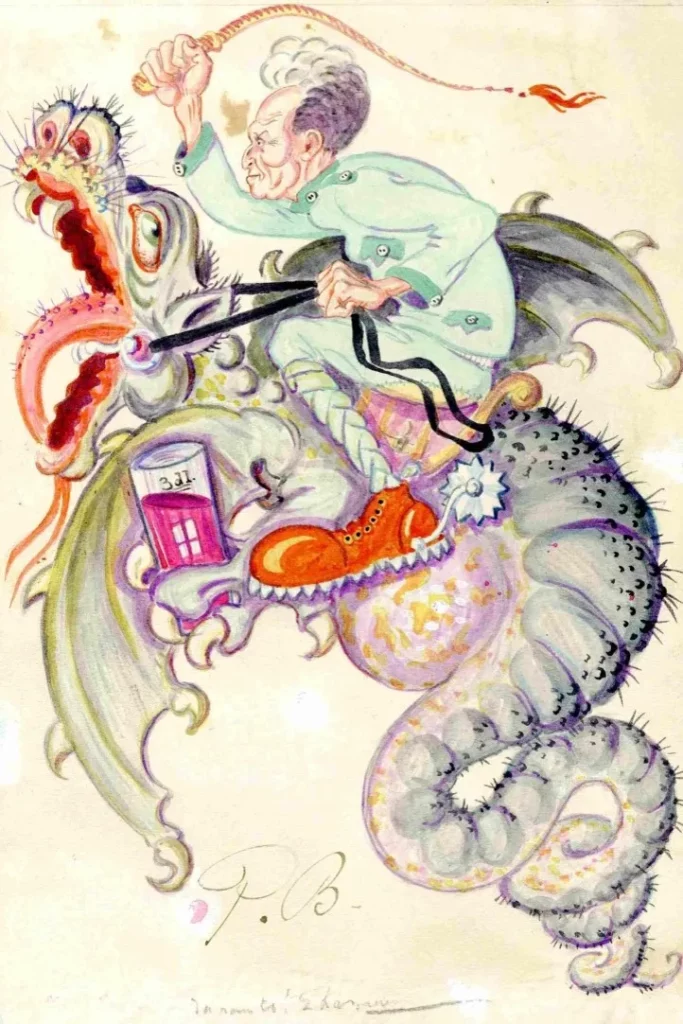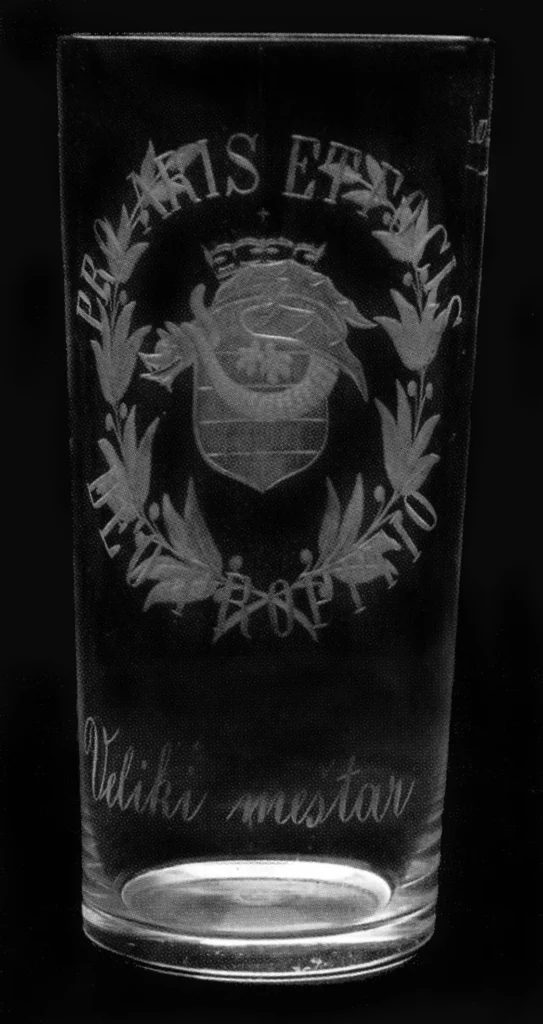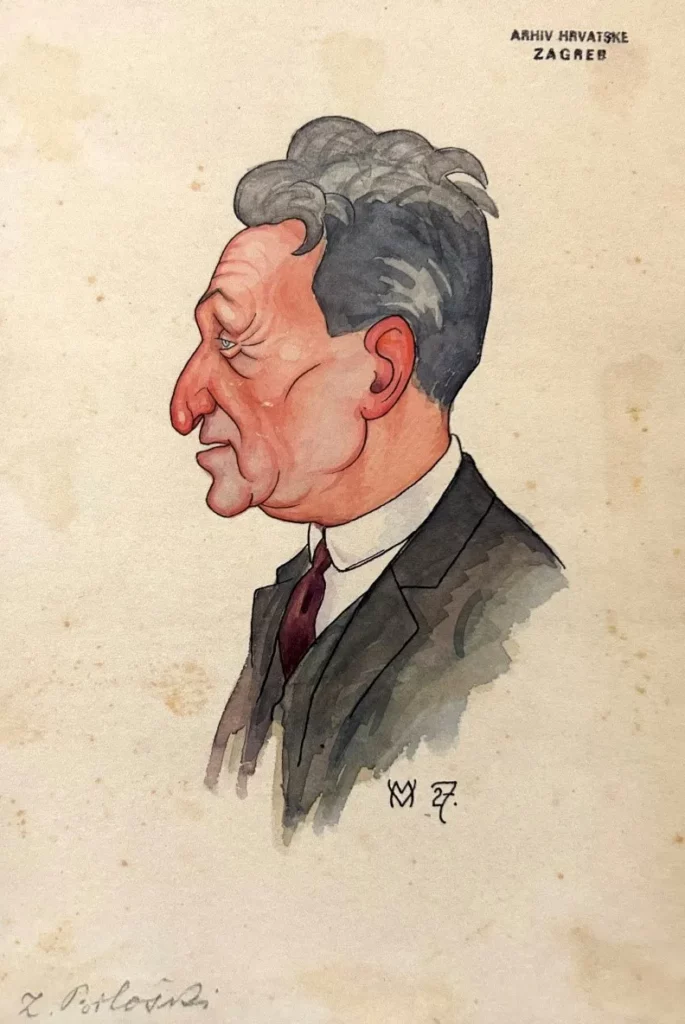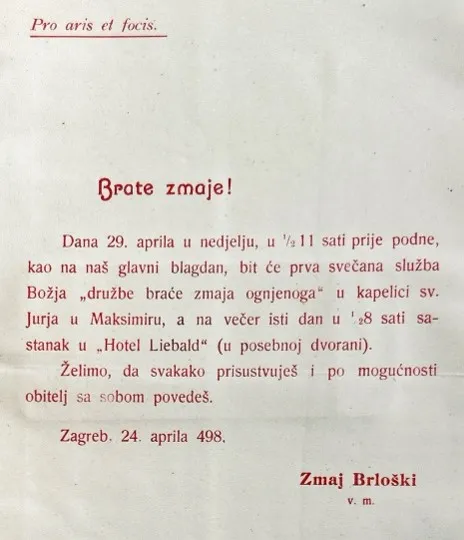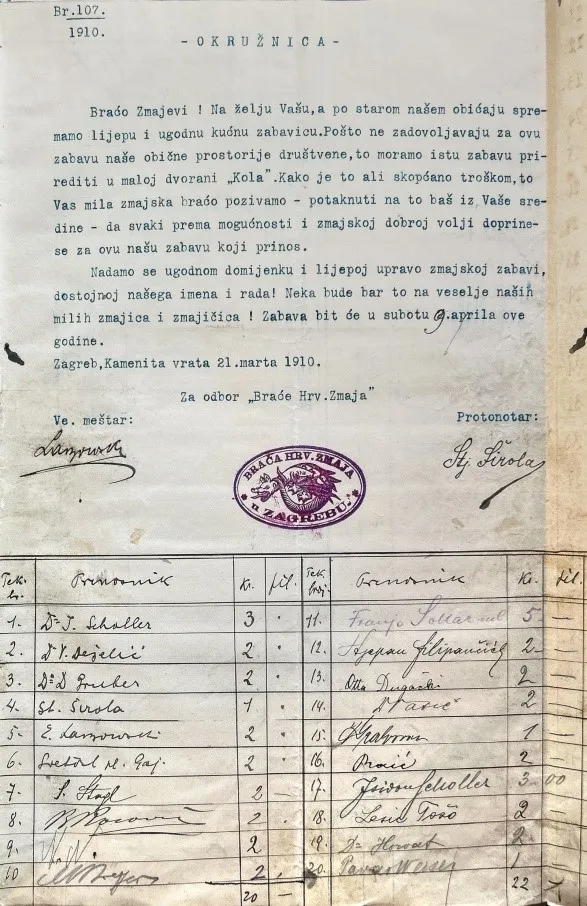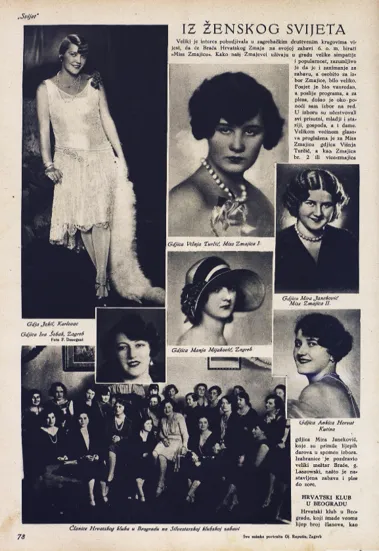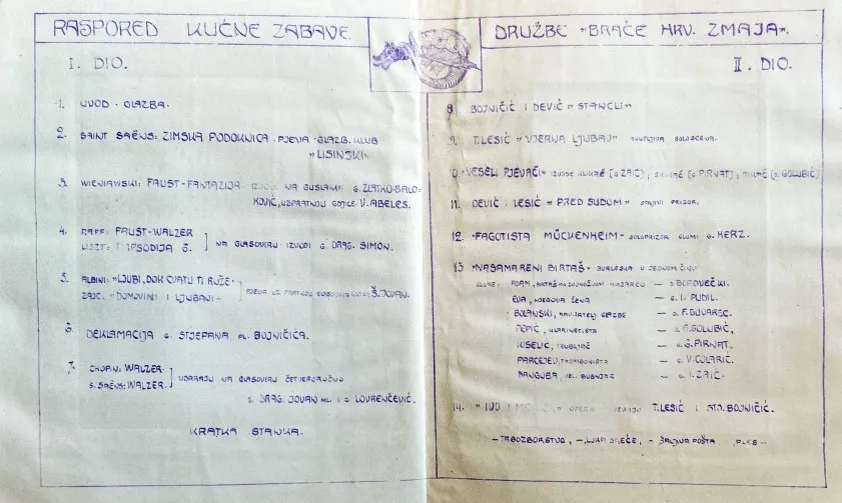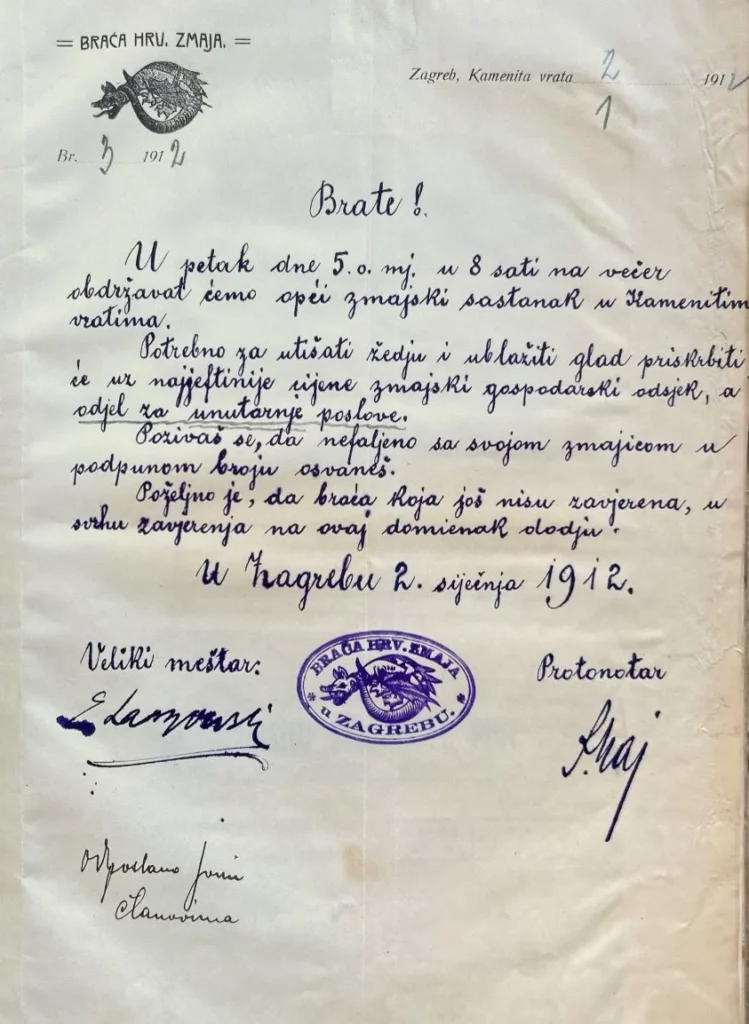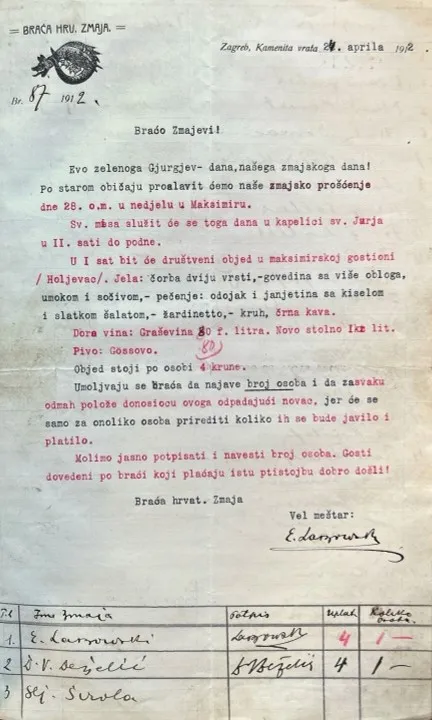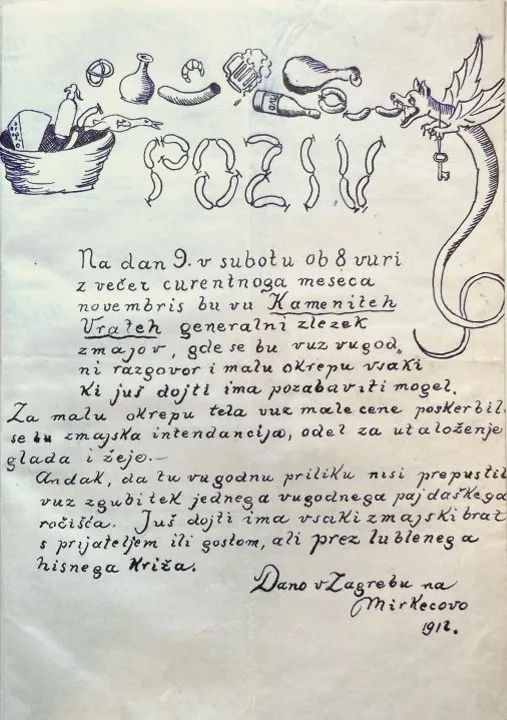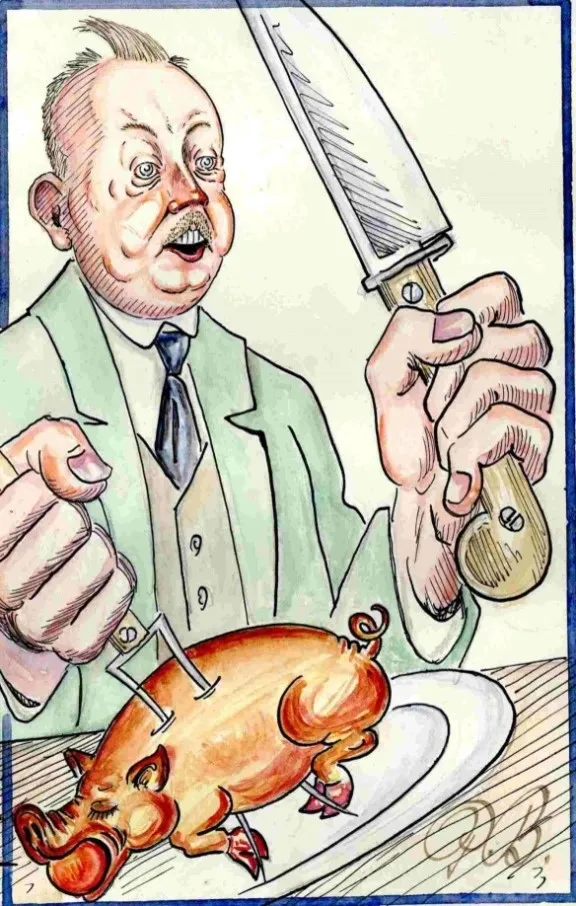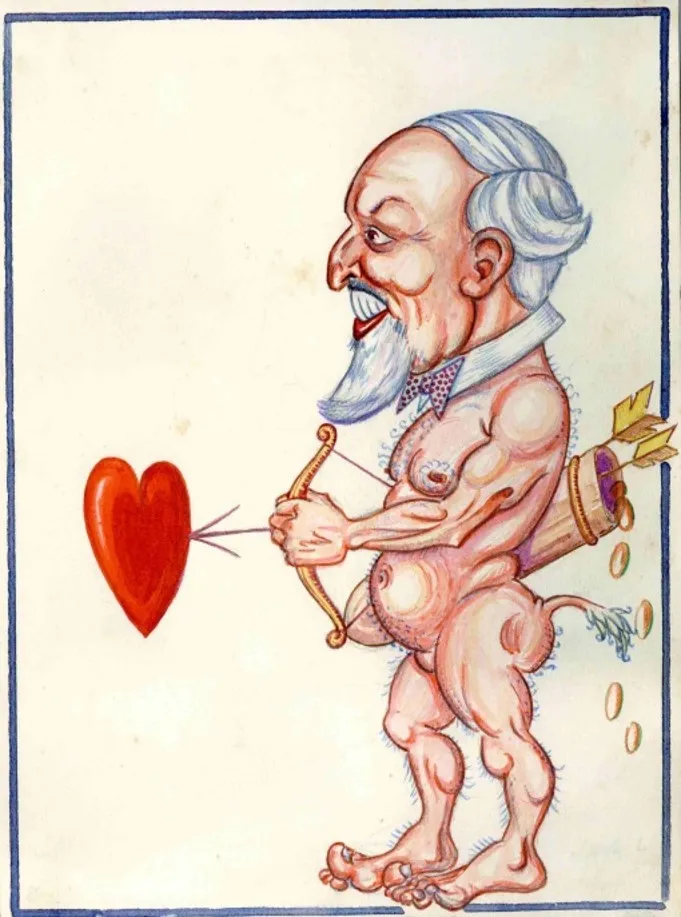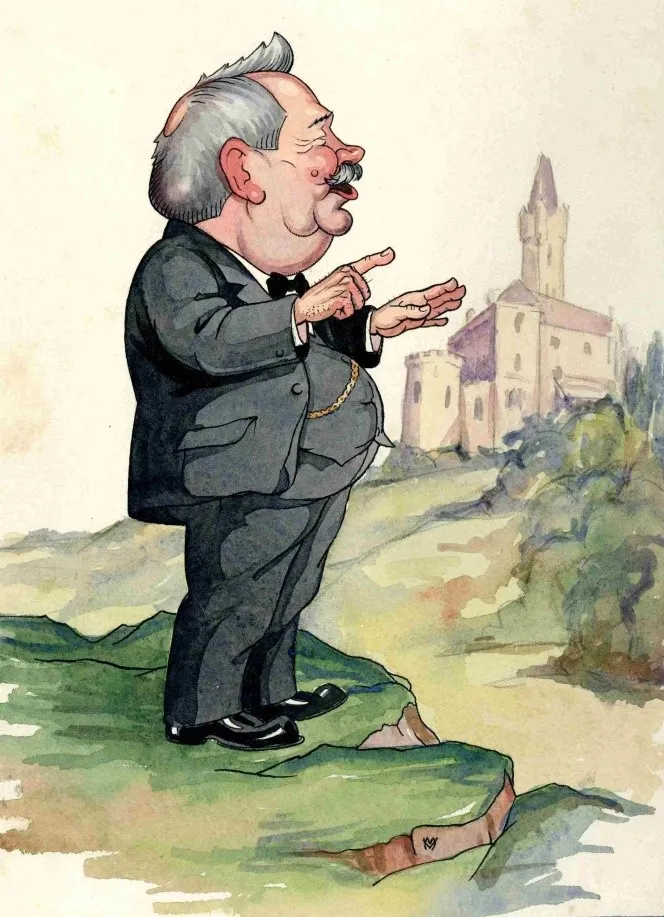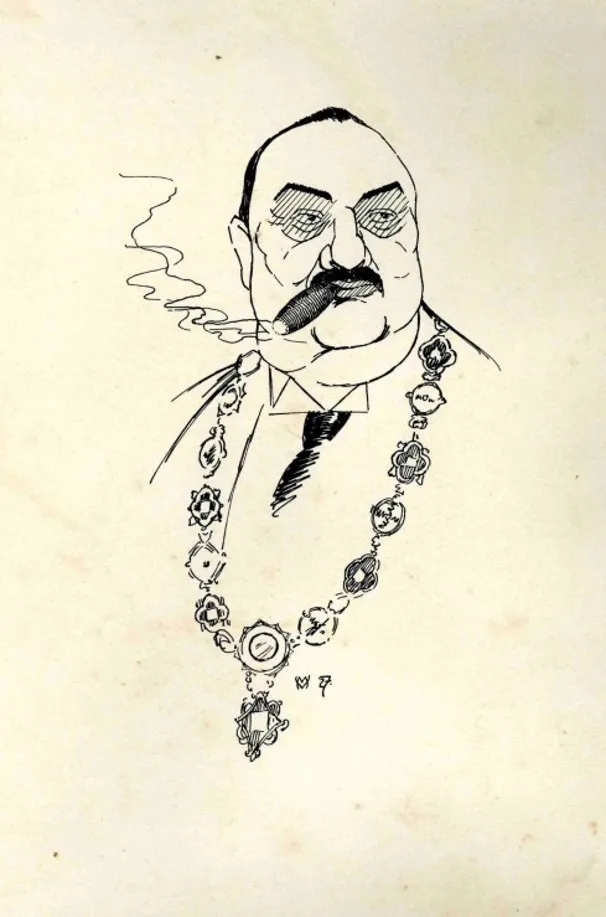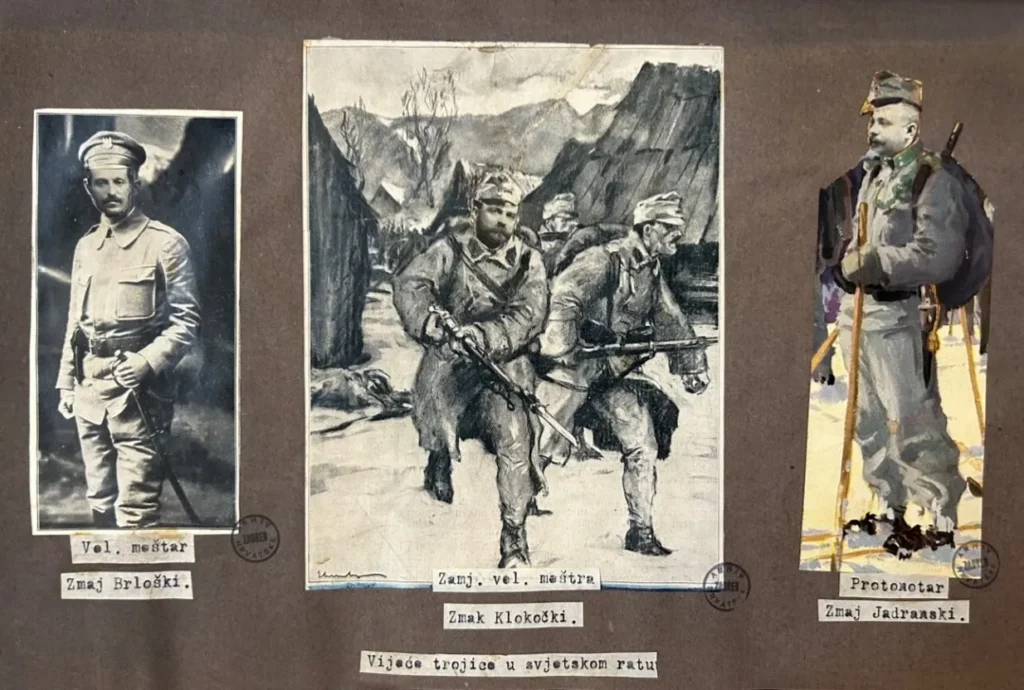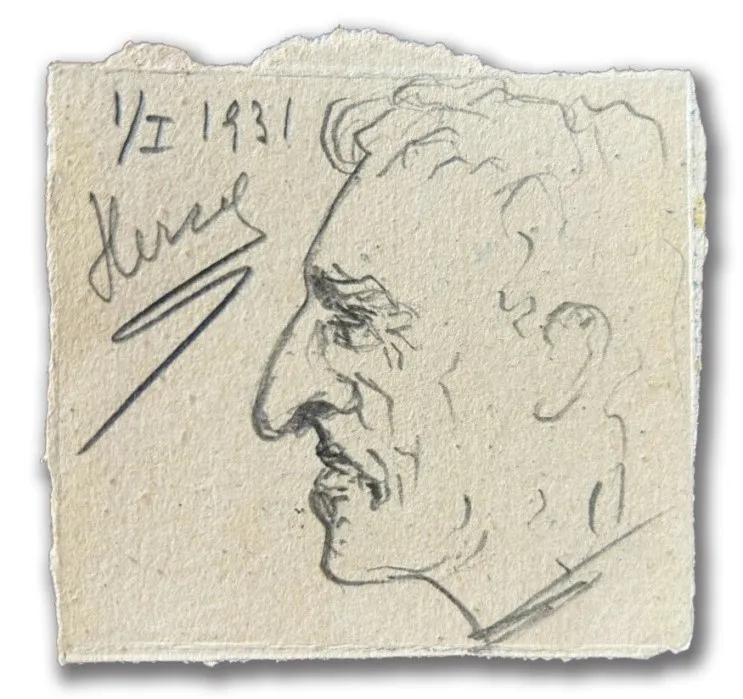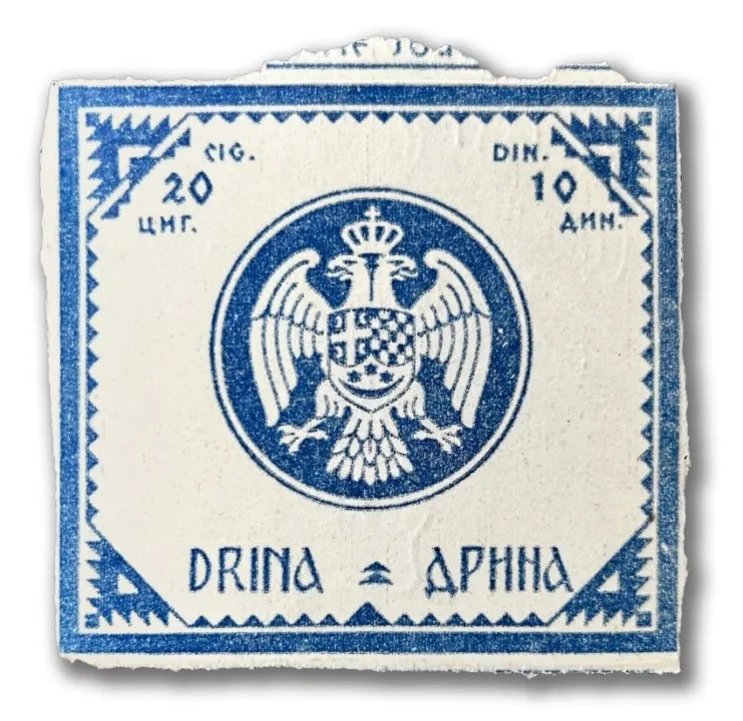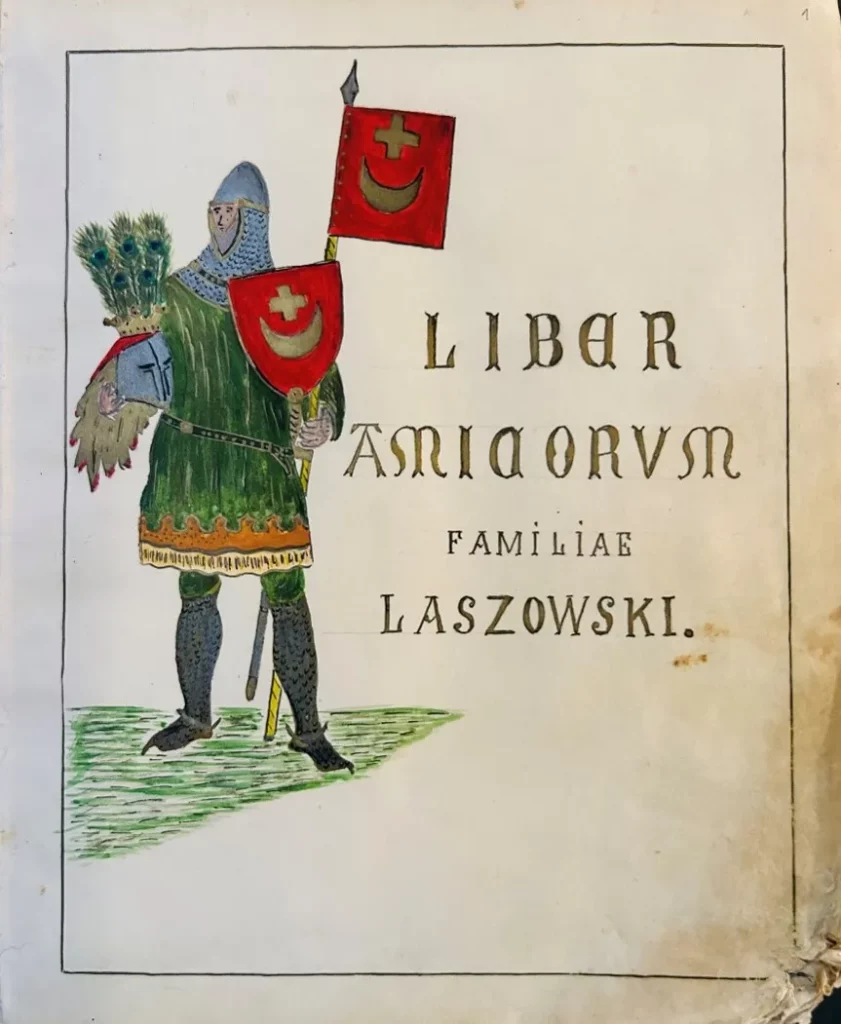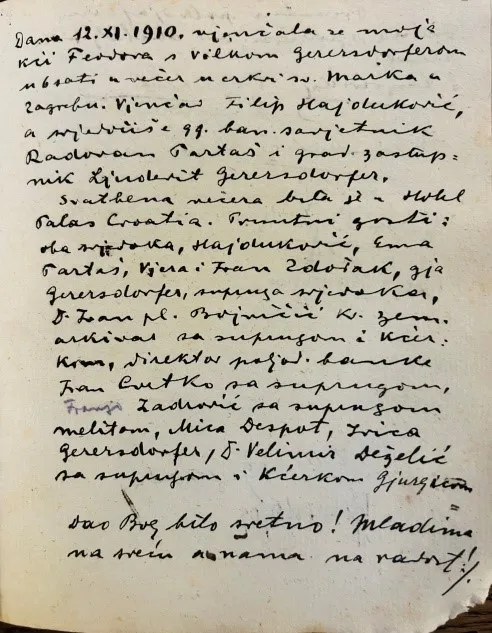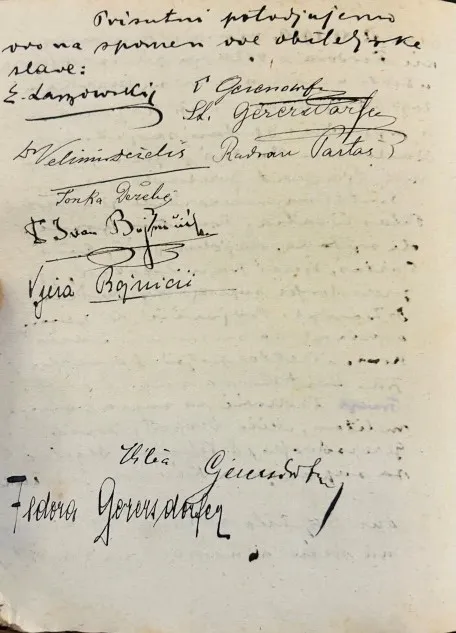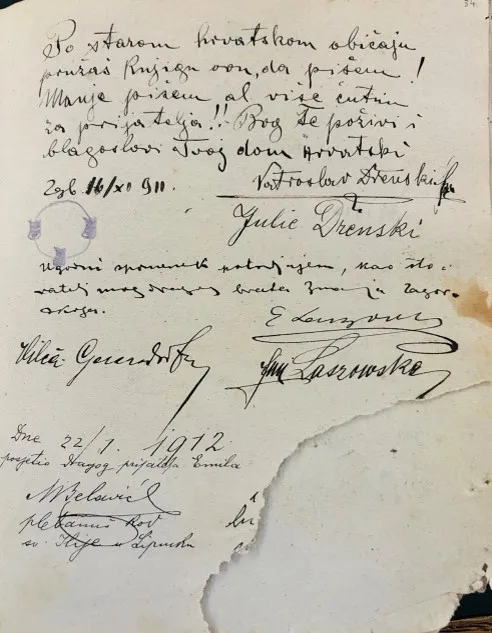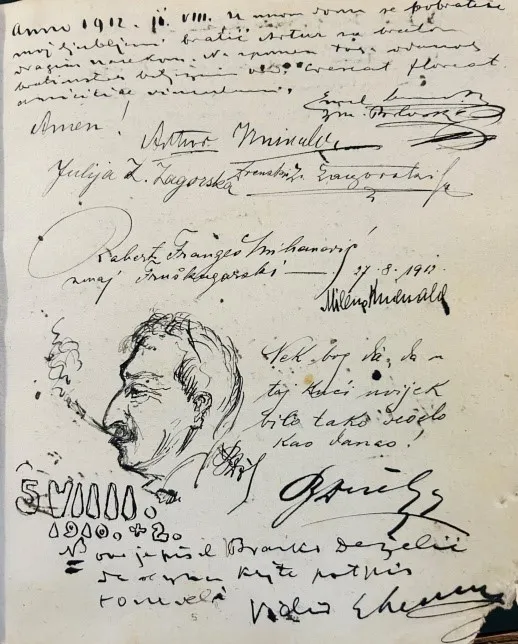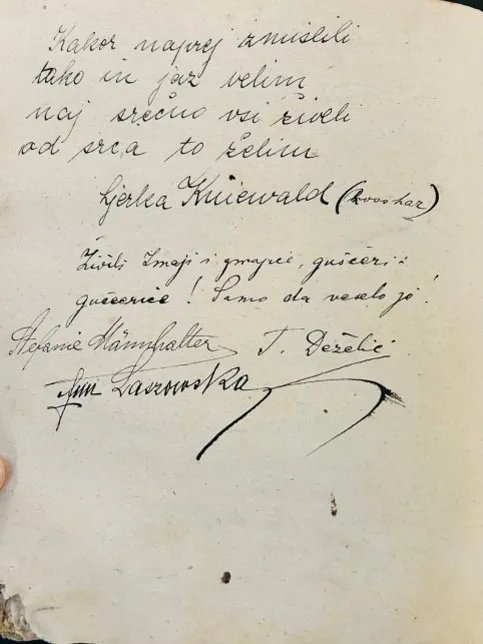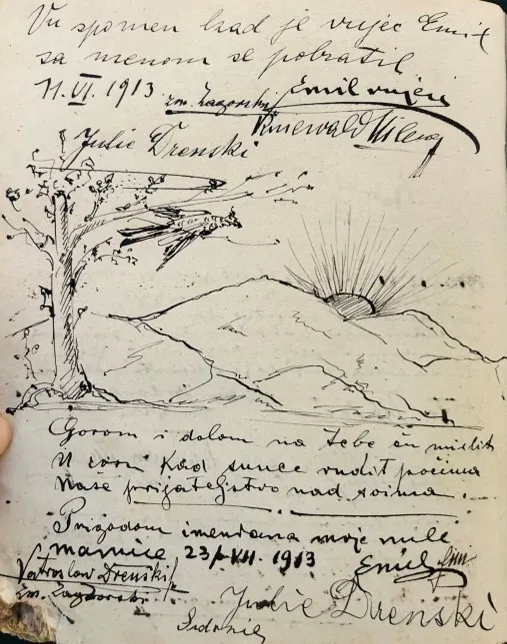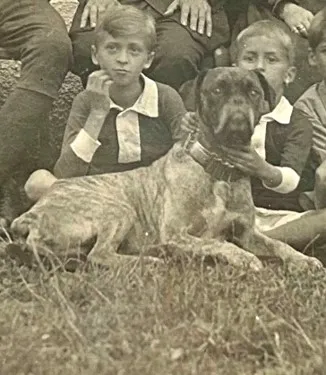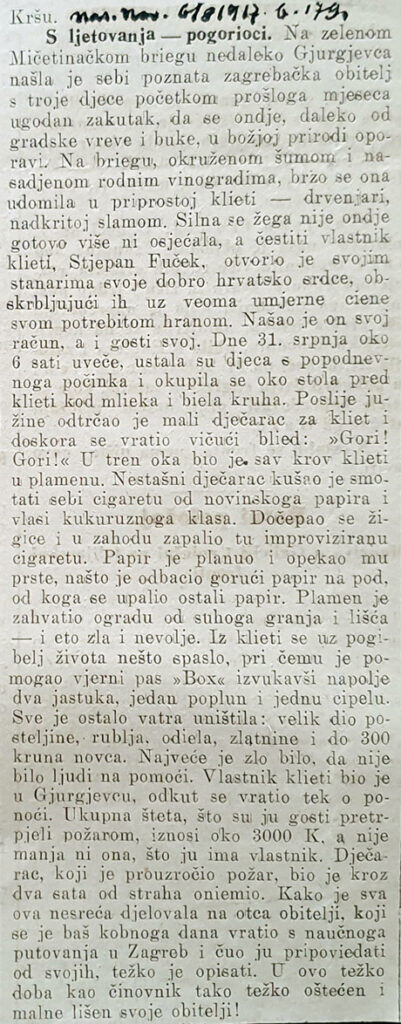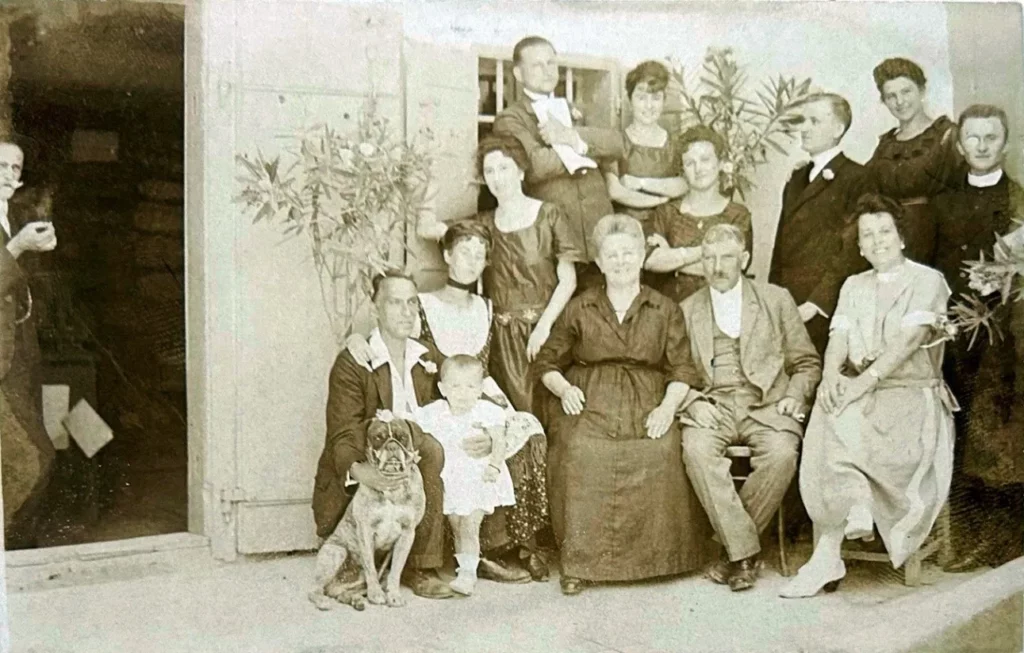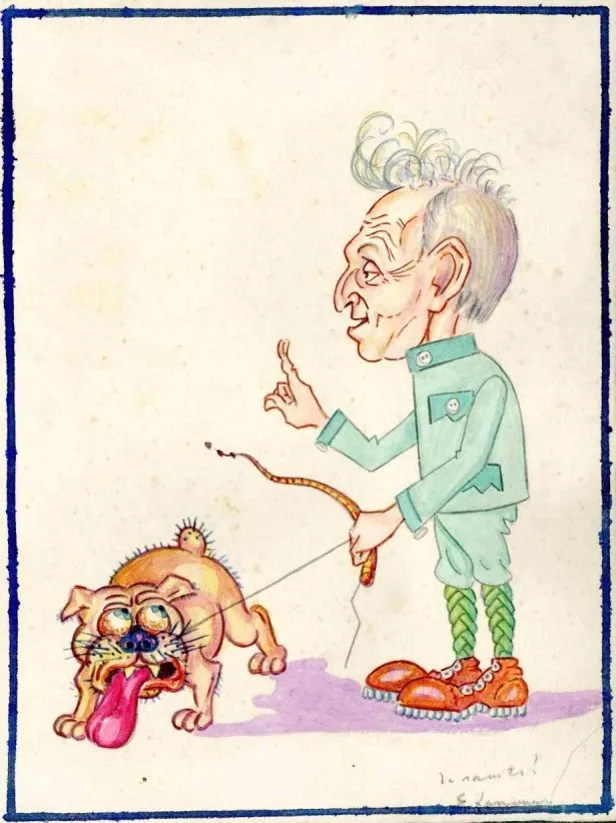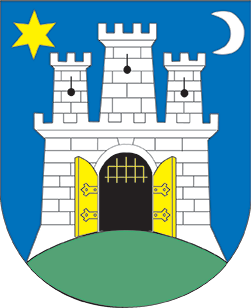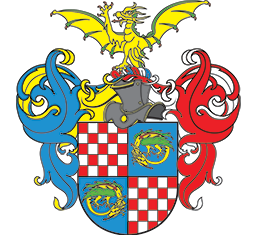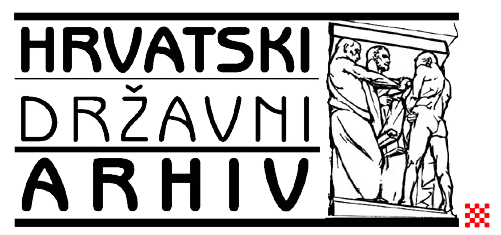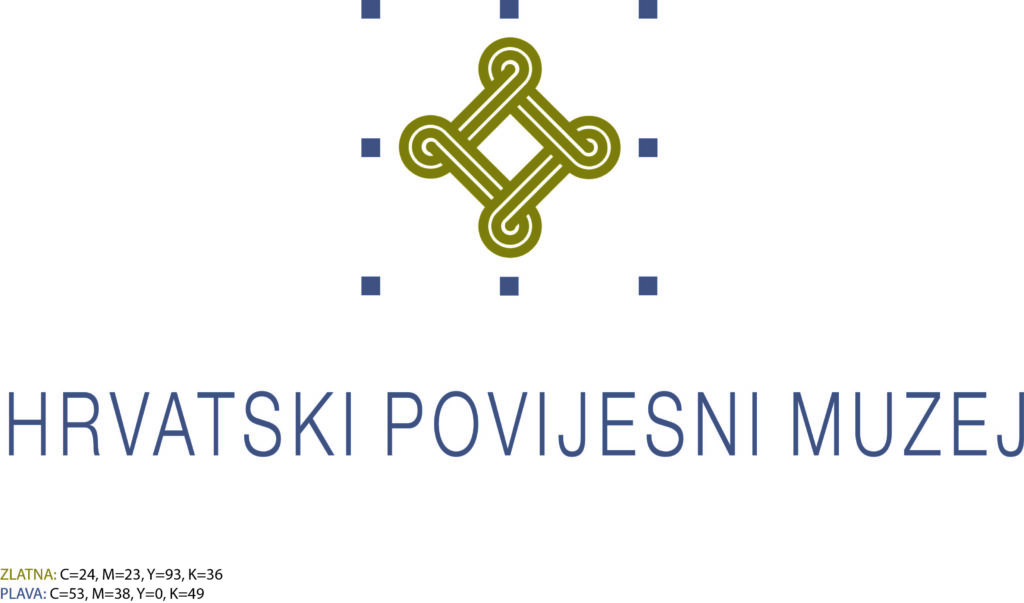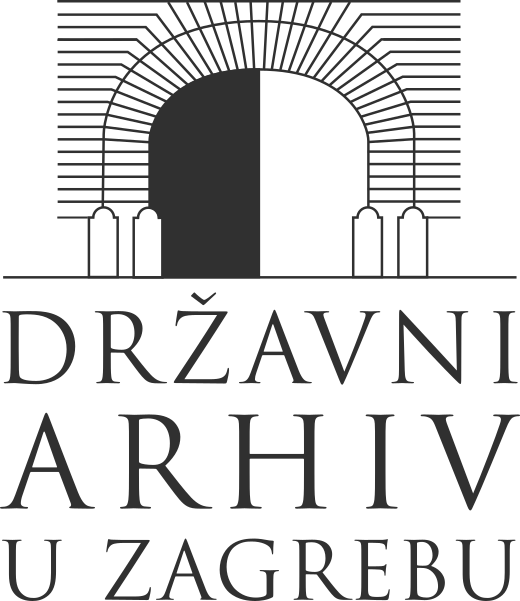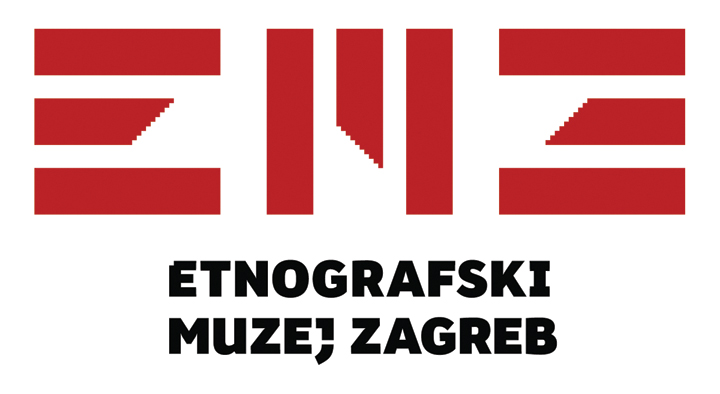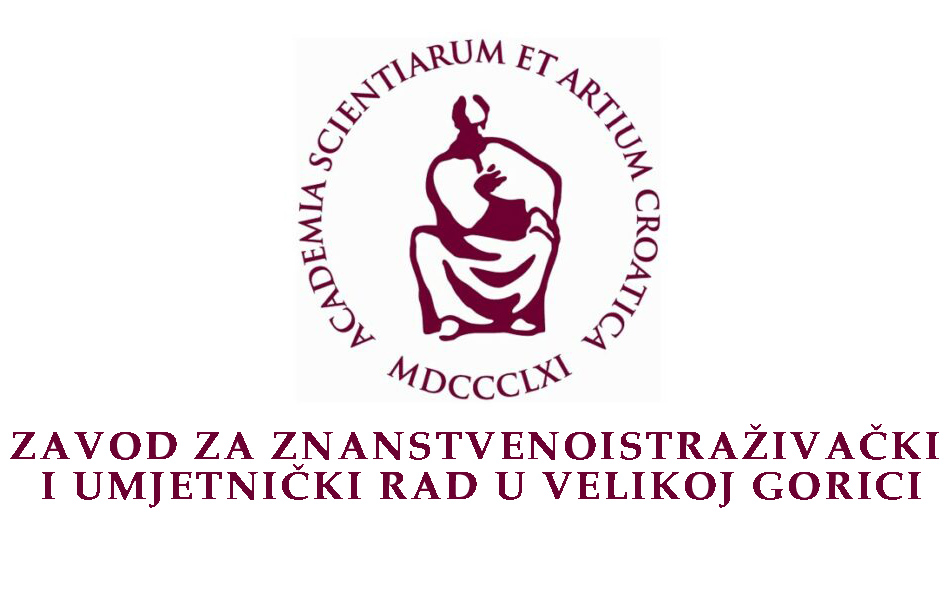13. I have always been a friend of merry company!
Enjoy wine, but with more wisdom,
Only moderation brings you joy!
(Križevački štatuti)
Laszowski displayed his affinities for leisure, enjoyment, and socialising from childhood and youth in Brlog, and throughout his life – with friends in taverns and restaurants during numerous social events that he meticulously organised or at private gatherings with family and friends, on private and official trips, enjoying food and drink as a true gourmet, sometimes quite modestly, sometimes lavishly, but meticulously written down in his Diaries and in the Liber Amicorum memoirs he kept throughout his life. There was an abundance of these gatherings so it is difficult to find a period in which there were no dragon-related or private festivities.
As sociable as he was, he lived a full and satisfying life. His socialising was almost as important to him as the business part of his life, or it would be more accurate to say that everything in his life was intertwined in such a way that it was difficult to separate where one activity began and another ended.
In principle, every dragon-related but also almost every private festivity where Laszowski found himself as an organiser had its protocol, menu, program, rules – all of it following and indeed, abiding by the famous Križevački štatuti (Wine-Companionship Rules of the Town of Križevci), wise old Croatian customs related to good fun with food and drink, which are inevitable part of all festivities, family and wider social gatherings.
I used to find much joy in making my guest drunk, especially the one who considers drunkenness the peak of merriment. But today I am different, I still offer drinks, but not by force but ad libitum, of course, to adhere formally to Križevački štatuti.
Revelry after revelry
There were many private parties, regular ones, for example, were celebrations of his birthday on April 1. All revelries, without exception, were filled with joy, food, drink, and accompanying anecdotes. Just for illustration, some stood out with very relaxed behaviour under the influence of alcohol – like the Christmas celebration of 1913 which lasted until the early morning hours, ending at dawn with him climbing ladders and singing loudly with his friend Vatroslav Drenski, when both fell and bruised themselves. At one of the celebrations, Velimir Deželić and Emilij experienced the true power of wine, so much that Laszowski himself was taken aback by it and later wrote in his diary:
Man, be moderate, this was shameful!
And in 1917, while returning from one revelry, Velimir Deželić, Franjo Šaban, and Laszowski were apparently so merry that when Šaban fell, he dragged Emilij onto the pavement and he gotten a bruise under his eye. Naturally, that quickly spread throughout Zagreb. This later angered Nikola Tomašić so much that he gave Emilij a proper lecture, pointing out the inappropriateness of his behaviour and the need to avoid bad company of his buddies. Private revelries were often merely a continuation of those started at some dragon gatherings. He always found time for fun and socialising with friends; they were important to him, especially the dragon brothers.
I have always been a friend of merry company. In merry company I have never spoiled a good agreement, instead I have always avoided any quarrel, and if it arose among others, I tried to resolve it and reconcile the quarrelling parties.
Dragon Society - the only treasure and consolation
Even when he was unhappy, dissatisfied with his family situation or lack of money, or certain disappointments at work, he found comfort among friends.
I have found treasure and consolation only in friends and my dragon society! They are my life, my hope!
In the Dragon Rules from 1905, among other things, it is stated in point 2 that the purpose of the society is to cultivate sincere Croatian friendship, sweetened with enjoyable fun within the bounds of aesthetics and morality… Also, in point 8 it is written that the Honourable Assembly will establish the time and place of the Society’s parties, which can be either home parties for selected members or general parties for all members, and point 9 prescribes that monthly contributions from membership fees are the means of payment for organised entertainment in the current month, while other contributions to the treasury are given for charitable purposes. The Main Assembly sessions were held in April on St. George’s Day, the patron saint of the Society, and on November 16, the day of the founding of the Society.
Through public lectures, erection of plaques and monuments, publication of literary works, affirmation of cultural heritage, and organization of cultural public events, the purpose of the Society was fulfilled, and by that, the Dragons were in their time known, recognised, and quite beloved. Thus, dragon parties and banquets were held on the occasions of the mentioned key dates of the Society, but also as an integral part of organised actions and events.
One of the rules was that discussing politics and religion at assemblies and banquets and on all occasions when the Brothers appeared in public as an association was prohibited. Even today, we would all benefit from following this rule.
Emilij's drunkards
Whether pejoratively or just by human nature, citizens of Zagreb called the Dragons Emilij’s drunkards. Their revelries were regularly accompanied by drinking from dragon glasses which, unlike the usual dosage of 2 dl, had a capacity of 3 dl!
Until 1919, the Dragons did not have their official headquarters (later it became the Tower above the Stone Gate), so they met in rented accommodation in various Zagreb taverns and so-called inns. There they held official meetings – assemblies – and very often banquets which were known for their joyful nature and often lasted until late at night. The first dragon’s lair, i.e. the first communal premises of the Society, which they rented for their assemblies, was the hall at the Liebald tavern, later the Zlatna kruna at Gajeva ulica 12. The first dragon party with a concert, dance, and raffle was held there on January 21, 1907. Parties and banquets were also held at the Kola hall, the restaurant of the City shooting range, the Reininghaus tavern (Gajeva ulica 9), the Tri gavrana tavern, Royal, etc.
In addition to various lectures, concerts, dances, literary performances, at banquets organised by the Society, raffles were also being held or, for example, a beauty pageant for Miss Dragoness in 1929. An article was published in Svijet magazine stating that the Dragons enjoyed great sympathy and popularity in the city, so the interest in entertainment and the beauty pageant was great, and the turnout was exceptional. After the program and the competition, the competitors were greeted by the Grand Maister Laszowski, and the dance and entertainment lasted until dawn.
Zagreb, February 1912
Semi-annual meeting of the Society members was held on February 8, 1912, on Ash Wednesday, the first day of Lent. The Society had previously sent a request to the Archdiocesan Office to grant exemption from fasting and abstinence to Roman Catholic members, to which the Archdiocesan Office responded affirmatively.
DBHZ
Some of the famous dragon celebrations related to the Chief of Dragons
Brethren of Dragons prepared an anniversary celebration marking the 25 years of Emilij Laszowski’s nonfiction work and the 50th birthday of Velimir Deželić Sr. in 1914 for the celebrants at the Zagreb Shooting Range. The program was diverse and the guests were numerous – family, friends, acquaintances, and public figures. Along with the performance of the Croatian anthem and literary performances, the Kolo choir performed the song that Brethren wrote and composed just for that occasion. Dioscuri were awarded ceremonial plaques, with speeches by the members of the Brethren but also by the Mayor Janko Holjac.
And ten years later, in 1924, the 35th anniversary of Laszowski’s nonfiction work and the 60th birthday of Deželić were celebrated. The Society then organised the Dragon Academy at the Art Pavilion. The celebrants were awarded diplomas and silver wreaths, followed by a diverse program, and a crowd of people, friends, and guests gathered.
Emilij’s 50th birthday in 1918 was also solemnly celebrated, in the Dragon House, accompanied by music, a touching speech by Deželić, his best friend, and recitations spoken by Štef Širola’s daughter Ružica according to her father’s verses. The brothers s then gave him part of the funds to buy what he missed the most – the remains of his hometown of Brlog. But that never happened.
Dragon caricatures
There are folders with caricatures of the members of the Society preserved at the premises of the “Brethren of the Croatian Dragon” Society at the Tower above the Stone Gate. They are the works of Branimir Petrović, an excellent caricaturist from the late 19th and early 20th century, and later Viktor Mohr. The latter was the protonotary of the Society from 1936 to 1946. He preserved the archives of the Society after its dissolution, which greatly facilitated the revival of the Society in the early 1990s. Thus, he prepared and equipped the aforementioned folders of caricatures with lists and brief descriptions of individual persons – members of the Society from the very beginning. Very humorous caricatures, full of details that evoke each individual, tell a story about the humorous side and the joy always attributed to the Dragons.
13.21 – 23: Caricatures of the Dragon Brothers – selection
Branimir Petrović, beginning of the 20th century
Caricatures of Ivan Surma, Zmaj Velikotaborski, member of the Maister Assembly who donated objects to the City Museum; Joso Bužan, Zmaj Sisački – painter, who immortalized the Great Maister Emilij Laszowski in his paintings, and Robert Frangeš Mihanović, Zmaj Fruškogorski, famous sculptor, Emilij’s friend.
DBHZ
13.24 – 27: Caricatures of the Dragon Brothers – selection
Viktor Mohr, beginning of the 20th century
Caricatures of Dr. Rudolf Horvat, Zmaj Koprivnički, historian; Milan Stahuljak, Zmaj Bjelovarski, composer and conductor; Ksaver Šandor Gjalski, Zmaj od Gredica, writer, and Vjekoslav Heinzel, Zmaj Splitski, architect, and the mayor of Zagreb.
DBHZ
Lotrščak's daughter
One of the most interesting aspects was the friendship between Emilij Laszowski and Marija Jurić Zagorka, who, while collecting materials for the book Kći Lotrščaka (Lotrščak’s Daughter), had many conversations with Emilij, a great connoisseur of Zagreb’s past, who was a source of many historical data. Through him, she got in touch with the county prefect of Velika Gorica Franjo Lučić because she needed to visit some villages in Turopolje. The friendship between Zagorka and Emilij, who willingly helped the writer and journalist in her work by directing her to archival sources, continued. In an article Svetinje grada Zagreba (The Shrines of the City of Zagreb) published in Jutarnji list in 1919, she described Laszowski and his City Museum with special reverence and poetry. This friendship was also noted in a humorous poem Our Literature.
Liber amicorum
If it is not written down – it is as if it never happened. We could say that was his motto. All his writings seem like that, even those documenting good fun and friendly gatherings. A memoir Liber amicorum familiae Laszowski bears witness to a wonderful culture of family events, friendships, gatherings on various occasions – birthdays, name days, baptisms, engagements, weddings, receptions, but also those entirely informal gatherings during summer holidays or mutual visits to relatives, friends, and Dragon brothers, in a fifteen-year period, from 1898 to 1913. Only Emilij’s true friends were allowed to sign the book. The first book was replaced in 1913 by the second one, Liber amicorum familiae Laszowski Szeliga Vol. II. Ab. 9.VIII. 1913. The reason for the replacement was not the fullness of the pages but an unfortunate anecdote with Emilij’s dog Leda, who bit into the mentioned memory book when it fell under the table, causing damage, so subsequent entries from August 1913 were made in a new book.
Since my faithful dog Leda, at half past one in the morning, bit at the corner into this dear book that fell under the table, I must preserve it as a dear memory of friends, in order to prevent further damage.
In addition to the Deželić couple, Velimir and his wife Tonka, Fini and Emilij, often visited and socialised with the families Širola, Drenski, Šandor and Olga Ballogh, Rudolf Lubynski and his wife Hilda, Svetislav Gaj, Franjo Bučar, M. Stahuljak, Franjo Šaban, and of course with cousin Nikola and his wife Paula Tomašić, and many others. Their names often appear in the House books, and especially the entries of Dr. Velimir Deželić, Emilij’s best friend.
I have many friends, which are people who know the meaning of friendship, whom I value above all. Of all my friends, one stands out, Dr. Velimir Deželić, in whom beats a sincere, selfless, and sacrificial friendly heart.
Deželić always spoke and wrote nicely about Laszowski, and in one entry in Liber amicorum from November 3, 1912, he addressed him thus: My dearest, most splendid, my most intimate friend Emilij. After Velimir’s death, Laszowski, wrote in his diary: … (I) lost everything in friendship.
13.32: Liber amicorum familiae Laszowski – cover
Zagreb, 1898 – 1913
Hardbound memory book with 52 pages, with a cover painted by Emilij Laszowski featuring a knight. The memory book also contains poems, dedications, notes about gatherings, small sketches, coats of arms of friends’ families, also by Laszowski.
HDA
13.33: Liber amicorum familiae Laszowski – selected pages
Zagreb, 1898 – 1913
Many friends and Dragon brothers, as well as family members, wrote in the memory book. Some entries are illegible, some are amusing, funny, some are sublime, full of good wishes; always a fascinating testimony of a busy and joyful socialising.
Dr. Velimir Deželić and Stjepan Širola wrote in it, and many just signed their names under a certain entry, such as Fini, Tonka Deželić, and others.
HDA
13.34: Liber amicorum familiae Laszowski Szeliga Vol. II. Ab. 9.VIII. 1913 – cover and selected pages
Zagreb, 1913
The second part of the House book of friendship, which is witness to family and friendly gatherings from August 1913 onwards.
HDA
Box - a faithful friend
He immortalized even his beloved Box, a boxer-breed dog, in his usual manner, writing about him and dedicating a manuscript My Dog Box – the Biography of a Faithful Dog from 1925 to him. Box had an interesting biography, from Berlin to Zagreb, and had changed three owners before coming to the Laszowski family. After causing damage on the property in Šimunec, with Emilij’s relatives the Vuk family, Box was given to Laszowski as a birthday present by his niece Danica in 1915. He was thin and in poor condition, and Emilij took pity on him and decided to take care of him. Box was visibly grateful; he lived for eighteen years and was a member of the family. Above all, he was Emilij’s dog, a faithful friend, who spent years with him, went to work with him at the Archives, to Stone Gate for the Dragon gatherings and meetings, on excursions… As he deeply valued all his sincere friendships, it is nice to read how tenderly he named this piece about his dog. When he died in 1925, Laszowski was devastated.
Several preserved photographs also feature Box, alongside the children and Emilij. As Box often spent time with the Dragons, he was also called the dragon dog. Anecdotes were recorded, such as the one in which during a fire on a holiday in a house near Đurđevac, caused by Emilij’s son’s negligence, where the family barely escaped with their lives, Box participated in rescue of things. There is a small article about it in the National Gazette; S ljetovanja. Pogorci. Box saved two pillows, a quilt, and a shoe from the burning house… Box was immortalised in a dragon caricature and in several family photos. As a dog lover, Laszowski had other dogs during his life, Leda, a female dog who almost ate Liber amicorum, and Bela.


